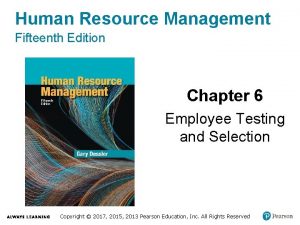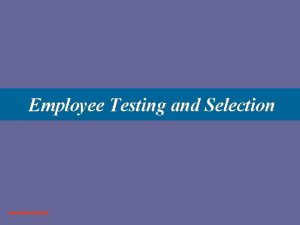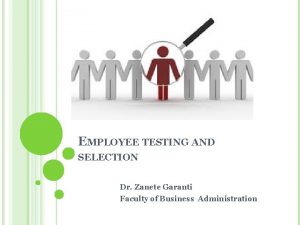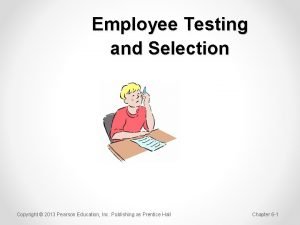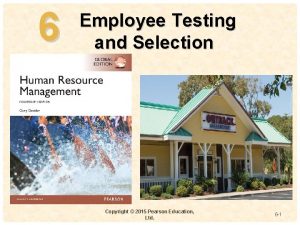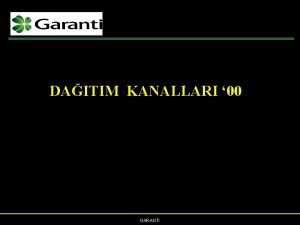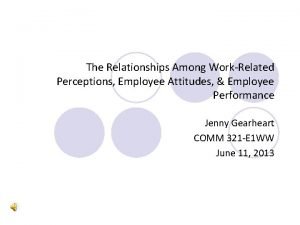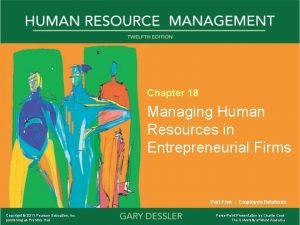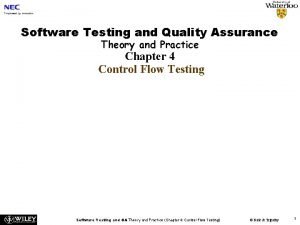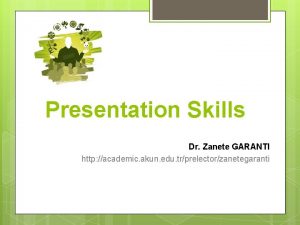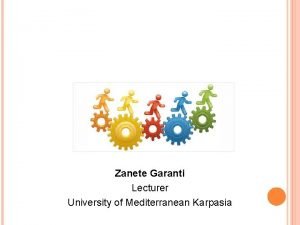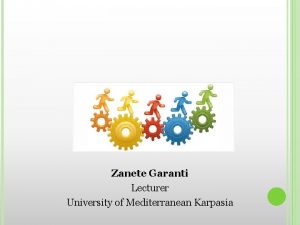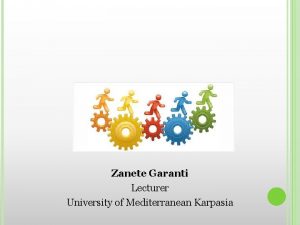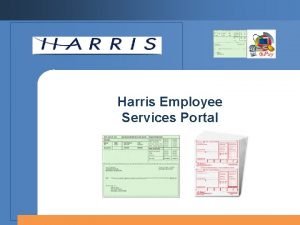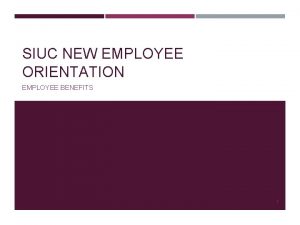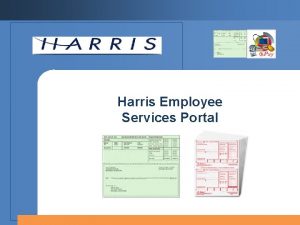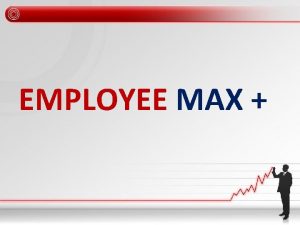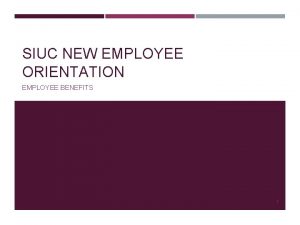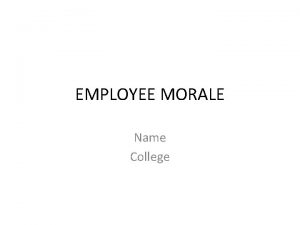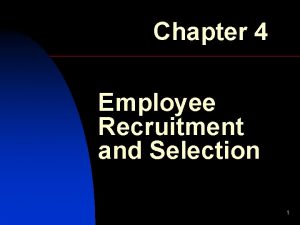EMPLOYEE TESTING AND SELECTION Dr Zanete Garanti Faculty



























- Slides: 27

EMPLOYEE TESTING AND SELECTION Dr. Zanete Garanti Faculty of Business Administration

DIFFERENCES BETWEEN RECRUITMENT AND SELECTION Recruitment is the process of identifying that the organization needs to employ someone up to the point at which application forms for the post have arrived at the organization Selection then consists of the processes involved in choosing from applicants a suitable candidate to fill a post

Attracting the right candidates to apply for a job can be an expensive process It is even more expensive when done badly because when unsuitable candidates apply for a job, then the post may need to be re-advertised so it is best to get it right first time! The starting point is to carry out job analysis (planning) to identify the sorts of skills, knowledge and essential requirements that someone needs to have to carry out a job

RECRUITMENT DEFINITIONS The process or art of finding candidates for a post in an organization Refers to the process of attracting, screening, and selecting qualified people for a job at an organization or firm Recruitment can focus on the internal labor market (pursuing staff already employed by the organization) or the external labor market (pursuing applicants from outside the organization)

INTERNAL RECRUITMENT This refers to the filling of job vacancies from within the business where existing employees are selected rather than employing someone from outside A business might decide that it already has the right people with the right skills to do the job, particularly if its training and development program has been effective

HOW TO DO INTERNALRECRUITMENT? Internal vacancies are usually advertised within the business via a variety of media: � Job offer to particular employee as a result of individual assessment � Internal database � Staff notice boards � Intranets � In-house magazines / newsletters � Staff meetings

INTERNAL RECRUITMENT: SUMMARY Advantages Disadvantages Knowledge of how a business operates will need shorter periods of training and time for 'fitting in’ Replacement of the person who has been promoted Person is used to working with others in the organization An insider may be less likely to make the essential criticisms required to get the company working more effectively Internal promotion acts as an incentive to all staff to work harder within the organization Promotion of one person in a company may upset someone else The strengths and weaknesses of an insider known. Avoid an outsider who may only be a success 'on paper’

EXTERNAL RECRUITMENT External recruitment is the process of searching outside of the current employee pool to fill open positions in an organization It can cost more than hiring from within, but it also provides an opportunity for a fresh outlook on the industry that a company may need to stay competitive

SUCCESSFUL EXTERNAL RECRUITMENT The HRM function has to take initiatives in four important areas to make the external recruitment efficient, quick and bringing the right quality of candidates: � Organization Brand Name (http: //www. forbes. com/sites/georgeanders/2012/10/11/the-20 -most- desired-employers-from-google-to-loreal/) � Correct Positioning of Job Posting � Channels used to promote the job vacancy � Speed of the Recruitment Process

EXTERNAL RECRUITMENT: SUMMARY Advantages Disadvantages Provides new ideas and new insight Loss of time due to adjustment Allows employee to make changes without having to please constituent groups Destroys incentive of present employees to strive for promotions Does not change the present organizational hierarchy as much No information is available about the individual’s ability to fit with the rest of organization

RECRUITMENT CHANNELS: JOB ADVERTISEMENTS IN MEDIA Advertisements are the most common form of external recruitment. They can be found in many places: � local and national newspapers, � notice boards, � recruitment fairs. It allows to attract wide range of applicants, but can be costly and time consuming process.

RECRUITMENT CHANNELS: JOB CENTERS Job centers are paid by the government and are responsible for helping the unemployed find jobs or get training. They also provide a service for businesses needing to advertise a vacancy and are generally free to use What could be advantages and disadvantages using job centers?

RECRUITMENT CHANNELS: RECRUITMENT AGENCY Recruitment agency provides employers with details of suitable candidates for a vacancy and can sometimes be referred to as ‘head-hunters’. They often specialize in particular employment areas e. g. nursing, financial services, teacher recruitment etc. They work for fee, that can be up to 20% of candidates’ salary What could be advantages and disadvantages using job centers?

HEAD HUNTING Headhunting refers to the approach of finding and attracting the best experienced person with the required skill set Headhunting is also a recruitment process that involves convincing the person to join your organization

RECRUITMENT CHANNELS: PERSONAL RECOMMENDATION Often referred to as ‘word of mouth’ and can be a recommendation from a employee, colleague at work, business partner etc. . A full assessment of the candidate is still needed however but potentially it saves on advertising cost. What could be advantages and disadvantages using personal recommendations?

RECRUITMENT CHANNELS: INTERNET Modern, fast and popular way to attract attention. Advertisements can be placed in: � Site of company: people who are interested in your company will find you! � Job advertisement site, � Recruitment agency site, � Other opportunities (banners , social networking sites etc. )

RECRUITMENT CHANNELS: DIFFERENT CONNECTIONS, EMPLOYEE LEASING, EMPLOYEE OURSOURCING ETC. Using connection with schools and universities to find new professionals. Employee Leasing- arrangement in which a firm (called subscribing firm) transfers its employees to another firm (called leasing firm). The subscribing firm leases its employees back as employees of the leasing firm and usually pays more for their services than their salaries at the time of transfer. This way the payroll and associated expenses and taxes of the leased employees become the leasing firm’s liabilities. Employee Outsourcing- company provides employees either on a short or long-term contract basis.

SELECTION Is the process of discovering the qualifications and characteristics of the job applicant in order to establish their likely suitability for the job position. A good selection requires a methodical approach to the problem of finding the best matched person for the job. Positive outcome • Selecting the right candidate • Rejecting the wrong candidate Negative outcome • Selecting the wrong candidate • Rejecting the correct candidate

SELECTION PROCESS Resumes/ CVs Review Initial Screening Interview Analyze the Application Blank Conducting Tests and Evaluating performance Preliminary Interview Core and Departmental Interviews Reference checks Job offer Medical Evaluation

SELECTION TECHNIQUES AND THE FREQUENCY OF USE Technique Percentage of firms reporting to use (USA) Reference checking 96 Interviews 94 Application forms 87 Ability tests 78 Medical examinations 50 Mental ability 31 Drug tests 26 Personality inventory 17 Weighted application forms 11 Honesty tests 7 Lie detector tests 5

APPLICATION FORMS 1. 2. Contains: � Personal information � Education, qualifications � Work experience, salary � Personality items � References Evaluation of application forms: Clinical method � In this method, all the information furnished by the applicant in the form is analyzed and inferences are made about applicant’s personality Weighted method � In this method, certain points or weights are assigned to each item in the application form

SELECTION TESTS Intelligence Interest Aptitude Personality Achievements Situational Graphology Others See the test examples: http: //www. jobs. mahle. com/C 12578 D 4003 EF 749/vw. Content. By. UNID/F 9 CE 3 FA 1 CF 74 AC 37 C 1257 B 3 C 005 E 4964/$FILE/Pre-Employment%20 Math%20 Morristown. pdf

Interviews Preliminary interview Panel Selection interview Unstructured Group In- depth Formal and structured Decision making interview Stress

NEXT CLASS: JOB INTERVIEW We are going to have a job interview role play on Tuesday, March 24. Here is the situation: � You are a graduate of UMK, Faculty of Business. You applied to work in a KOOP bank as a bank clerk. � Prepare yourself for a job interview as both interviewer and an applicant. � You will be assested on ability to carry out both roles (it will count as your first quiz). Attendace is compulsory! Find examples of the job interview questions and prepare both to ask them and to answer them: http: //jobsearch. about. com/od/interviewquestionsanswers/a/top-50 -job-interview-questions. htm

INDUCTION Induction is a structured and standardized means of communicating corporate goals, policies, procedures and standards to new staff. It assists with their socialization into organizational values and culture. It is a supportive process that includes mentoring, coaching and the provision of information and learning materials that address technical and professional aspects of the job. It is primarily work-based and, as such, is the responsibility of the department and supervisor. Induction is an opportunity to discuss what systems are in place for managing and supporting staff, including their career development, training, and performance management.

A PROPERLY CONDUCTED INDUCTION SHOULD: Reinforce the staff member’s decision to join the organization, Enable staff to quickly commence work in an effective manner, Clarify expectations and reduce anxiety, Increase the predictability of a staff member’s behavior, i. e. that he or she will act in accordance with their terms and conditions of employment and in the interest of the organization, Promote enthusiasm and excitement about the staff member’s role, Link the new staff member to the organization’s work and collegial networking structures, Provide information about staff member’s rights and obligations.

APPLICATION HOMEWORK Chapter 6 of Dessler HRM book: http: //www. prenhall. com/behindthebook/0131746 170/pdf/Dessler 2_When_On_Your_Own. pdf
 Zanete garanti
Zanete garanti Chapter 6 employee testing and selection ppt
Chapter 6 employee testing and selection ppt Employee testing and selection
Employee testing and selection Employee testing and selection summary
Employee testing and selection summary 2013 pearson education inc. answers
2013 pearson education inc. answers Employee testing and selection
Employee testing and selection Lösev bağış garanti bankası
Lösev bağış garanti bankası Garanti wap
Garanti wap Employee attitudes and employee performance
Employee attitudes and employee performance Employee selection
Employee selection Managing human resources in small and entrepreneurial firms
Managing human resources in small and entrepreneurial firms Two way selection and multiway selection
Two way selection and multiway selection Multiway selection in c
Multiway selection in c Mass selection
Mass selection Positive negative testing
Positive negative testing Cs3250
Cs3250 Balancing selection vs stabilizing selection
Balancing selection vs stabilizing selection Artificial selection vs natural selection
Artificial selection vs natural selection K selection r selection
K selection r selection Natural selection vs artificial selection
Natural selection vs artificial selection Difference between continuous and discontinuous variation
Difference between continuous and discontinuous variation Disruptive selevtion
Disruptive selevtion K selection r selection
K selection r selection Natural selection vs artificial selection
Natural selection vs artificial selection Path selection in software testing
Path selection in software testing Domain testing
Domain testing Kv charts in software testing
Kv charts in software testing Du path testing
Du path testing

